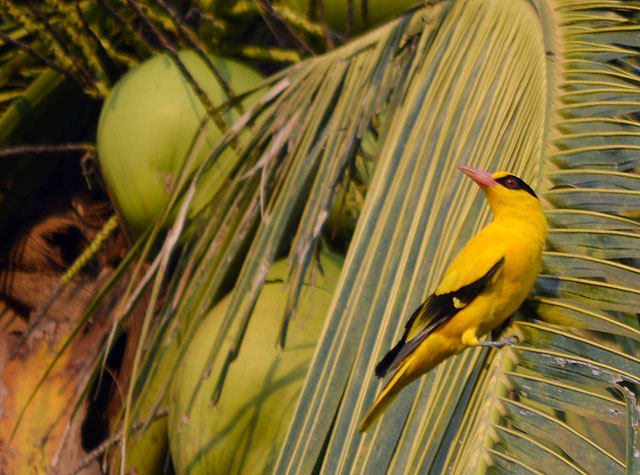Recently,
a number of interesting passage migrants were recorded at the Air Hitam Dalam
Educational Forest in mainland Penang and I was hoping to catch some of them
myself before they carry on with their migration. I reached the locality just
before it got bright and was greeted by an eerie growl from one of the trees
next to the car park. However, fear did not overcome me but excitement
certainly did. It was just the resident pair of Spotted Wood-Owls proclaiming
their territory and I am elated that they still lingered on here after all the
destruction done to this site by the strong winds last month. I observed the
pair’s interaction patiently and unobtrusively. In this light, I knew I could
not obtained any reasonable images but it did not stop me from trying. As the
sky started its transition from midnight blue to amber, the nocturnal pair
retreated deeper into the forest leaving me with nothing but a beautiful memory.
And this crappy record shot.
Morning
followed shortly after and it was a beautiful one indeed. Blue sunny skies as
far as the eye can see. The melodious call of the Black-naped Oriole diverted
my attention to a clump of coconut trees just beyond the border of the reserve.
A male bird was soaking in the soothing rays of the morning in the golden light.
A Black-naped Oriole is nothing to shout about as it is a common bird even in
parks and gardens. However, being common does make a beautiful bird any less
appealing and I would not be able to forgive myself if I did not even try to
capture this encounter with my camera.
It
is one of the commonest birds in the country but the Common Myna is full of
character. And when a few of them get together, they can raise a ruckus. Anyway,
the three of them broke the morning’s serenity from the top of a coconut tree and
that was enough to earn them a place in my blog posting this time.
My
visit to this local patch of mine reunited me with a girl that I have not seen
for a very long time. It is good to know that the lone female Indochinese
(Tickell’s) Blue-Flycatcher of this location is doing well. And she is still in
the company of a male Mangrove Blue-Flycatcher. Whatever makes you happy,
girl...
Here
in Air Hitam Dalam, the Olive-winged Bulbul is the most conspicuous bulbul even
outnumbering the Yellow-vented Bulbul. Today, a pair of them performed
exceptionally well and I gave them the attention they so truly deserve.
My
search for interesting passage migrants did not go according to plan – most things
do not when it comes to birding. Only the commoner ones were encountered like
this rather striking Brown Shrike.
Just
as I was about to seek better fortunes elsewhere, a Crow-billed Drongo swooped
pass overhead, caught an insect and alighted on a nearby branch to feed. I took
my time to enjoy the last encounter for my visit to this local patch. The paddy fields which are
to be my next destination will just have to wait as an opportunity of this
nature does not come by all that often.
It
looked like an adult bird and although I have encountered better looking
individuals, a Crow-billed Drongo performing well can always brightened up my day. It is no means a rare migrant but it is uncommon enough to have my
undivided attention.
There
was nothing unexpected to be found at the paddy fields of Permatang Pauh in
mainland Penang. The usual migrants are starting to build up in numbers which
is a good sign. A recently ploughed patch produced a flock of
Grey-headed Lapwings but this locally common migrant do not usually allow
prolonged observations and it was no different this time.
A
fellow birder, Khor, has reported the arrival of White-shouldered Starlings to
the locality and this uncommon migrant would certainly improve the outcome of this
trip. Unfortunately, they were no where to be seen. The Daurian Starlings were
back in full force and a humble estimation of the birds present throughout the locality
was a hundred strong.
Every
Daurian Starling was given a second look not because the species is rare or new
to me but for the possibility of the rare Chestnut-eared Starling among them. There
was a particular fruiting tree next to the paddy fields that was drawing in the
starlings and naturally, I was anchored to the spot for a long time. By now if
there is no mention of the Chestnut-eared Starling, you will probably be able
to draw your own conclusion of my efforts.
The
Daurian Starling used to be called the Purple-backed Starling. This male that
was foraging at the tip of one of the tree branches in the full sun shows you
exactly how the old name was derived. The striking upperparts of this male
starling wrapped things up for the day and although nothing extraordinary was
encountered, the commoners have done enough to keep the birder in me satisfied.


















2 comments:
Waiting for your news on the arrival of the tiaga and other rarity
bro............
I am also waiting, Mike...
Post a Comment